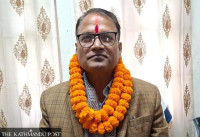National
Guthi Sansthan was in dark for years about how its land was being used
National Vigilance Centre’s investigation found that the land was being exploited for commercial purpose.Prithvi Man Shrestha
The Religion Culture Preservation Committee, a social institution, handed over six ropanis and 14 aanas of land at Narayanchaur in Kathmandu, owned by Guthi Sansthan, to another social institution—Satya Sai Kendra on May 9, 1998.
The Guthi Sansthan, an independent institution entrusted with the task of taking care of religious, cultural and social heritage of the country, had no idea about it. Officials said they don’t know how the Guthi-owned land went into the hands of the committee, which subsequently handed over the land to Satya Sai Kendra. The National Vigilance Centre, which conducted an investigation into the ownership of the land, said that only the Guthi Sansthan itself or the Nepali government (Cabinet) has the authority to give public land to any organisation for a particular use.
A recent report of the National Vigilance Centre concluded that the former officials of the Guthi Sansthan were involved in the handover of the land to the committee and that they should be held accountable.
Based on this conclusion, the National Vigilance Centre has decided to send the report to the Commission for Investigation of Abuse of Authority for further investigation.
The Guthi Sansthan and the National Vigilance Centre have not found any trace of the existence of Religion Culture Preservation Committee.
“Documents show that the Guthi Sansthan had given the land to the Religion Culture Preservation Committee. But it handed over the same land to Satya Sai Kendra without our knowledge,” said Hari Prasad Joshi, deputy administrator at Sansthan. “We came to know about it only about a decade ago. We mounted pressure on Satya Sai Kendra to vacate the land, but we failed to do so after former government secretaries intervened.”
While the Satya Sai Kendra used a certain portion of the land for itself, it provided the rest of the property to Harihar Narayan Samaj, a grouping of local Khadgi community, also without the consent of the Guthi Sansthan.
The Harihar Narayan Samaj built a three-storey community building after taking building permits from Kathmandu Metropolitan City on December 31, 1991; again, the Guthi Sansthan was kept in the dark.
The Satya Sai Kendra itself also admitted to having received the land from Religion Culture Preservation Committee without knowing that the land belonged to the Guthi Sansthan.
“Only after Guthi Sansthan started to inquire about it, we knew that it belonged to Guthi,” said Dol Bahadur Khadka, chairman of Satya Sai Kendra. “When it gave a part of the land to local Khadgi community as per their demand, we were not aware that the land belonged to Guthi Sansthan.”
The land, in fact, had come under the Guthi Sansthan on August 22, 1991, from a private Guthi—Harihar Narayan Guthi. Then, the Guthi Sansthan asked the Satya Sai Kendra to pay the rent for the land as per the market rate. But the latter refused to pay the rent as per the market rate, arguing that they were using the space for social services and religious activities and not for making profit.
The two sides ultimately signed a deal under which the Satya Sai Kendra would pay Rs200 per month for nearly seven ropanis of land, according to the Guthi Sansthan officials.
Nearly one and a half years ago, the rent was revised to Rs3,000 per month.
A separate agreement was also signed between the Guthi Sansthan and Harihar Narayan Samaj under which the Samaj would pay Rs3,000 per month.
The National Vigilance Centre had conducted an investigation after a complaint was registered saying the land was provided to the Satya Sai Kendra at a very low rent without any competition.
During its probe, the National Vigilance Centre found that Harihar Narayan Samaj had given a space on the northern side of the community building on rent for Rs20,000 to run a restaurant.
Satya Sai Kendra’s Chairman Khadka said they were not concerned about how Harihar Narayan Samaj was using the land as the Guthi Sansthan had signed a separate agreement with Samaj.
“In our case, we are running a diagnostic centre where we provide free of cost treatment to patients and we also conduct various religious activities,” said Khadka. “There is no source of income for us, except donations that people give voluntarily.”




 8.12°C Kathmandu
8.12°C Kathmandu















